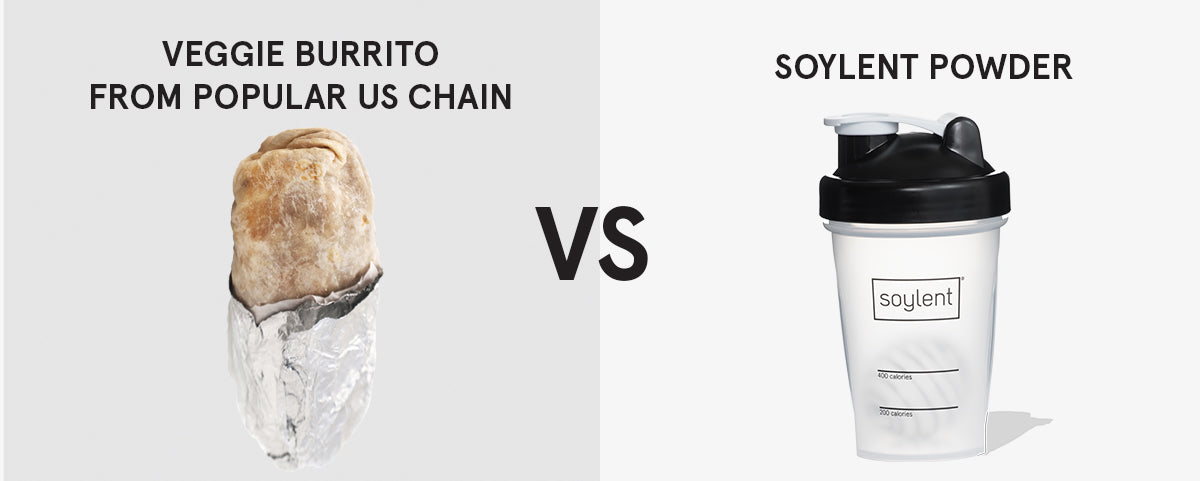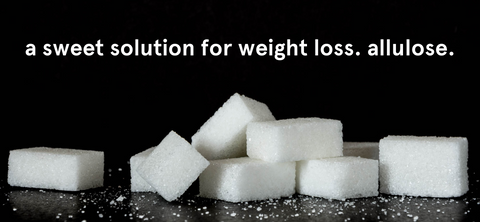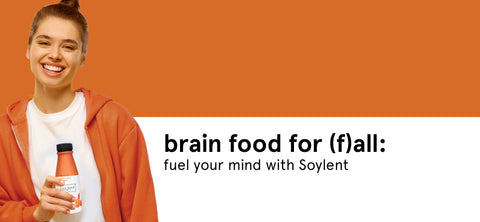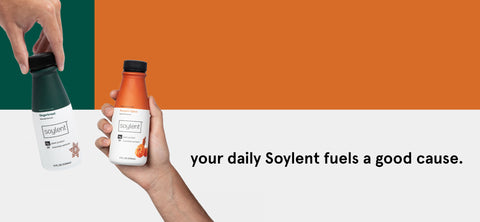
We are all faced with numerous food choices every day. Making healthy choices can be tricky, especially when time is tight.
Many options people consider to be healthy are actually not. Even the foods we consider healthy can be high in carbohydrates, sugar, low in protein and especially low in micronutrients.
Soylent vs. veggie burrito.
We took a deep dive into the nutritional attributes of Soylent Powder compared to some popular breakfast and lunch foods that are often considered healthy choices. Let’s take a closer look here at the nutritional impact of choosing to shake up your favorite flavor of Soylent powder vs. dropping by the strip mall to grab a burrito.

No time to eat? Reach for Soylent.
Soylent has evolved to be more nutritious than your average meal, and unlike most protein drinks on the market, Soylent has a satisfying 400 calories, 26 vitamins and minerals, essential macronutrients including plant-based protein, healthy unsaturated fats and both fast and slow-burning carbs for a steady release of energy.
Who wins for calories?
At 400 calories, Soylent has fewer calories than most typical breakfast or lunch meals such as our favorite veggie burrito.
A 400 calorie count may seem high, but consider that Soylent is a meal and will provide you with a substantial amount of nutrients to keep you full.
We found that a drink with 400 calories per 14 fl oz serving is enough to keep you full without weighing you down. Also, it is lower than many typical breakfasts or lunches, yet more satiating than your typical snacks.
The comparison between Soylent products and other foods does get interesting if you go beyond calories and compare the macronutrients that make up the calories.
Let’s look at carbohydrates.
Carbohydrates are part of a healthy diet, but the various types of carbohydrates play very different roles in the body.
Net carbs represent the amount of carbohydrate available as an energy source to the body and can be calculated by taking the total carbohydrates minus the dietary fiber. The net carb amount can translate into very different functional outcomes depending on whether the carbohydrates have a high glycemic index (fast burning) or a low glycemic index (slow burning).
Soylent Powder is formulated with both high glycemic and low glycemic carbs for a steady release of energy. Compared to our veggie burrito example, Soylent contains 40% of the carbs found in the burrito and 37% of the net carbs.
Fiber is important for digestion and also plays a key role in satiation. Fiber helps slow down digestion and therefore keeps hunger at bay. It's also essential to feed our microbiome and better absorb nutrients. Soylent Powder contains 6g of fiber (20% DV) per serving, with cellulose as a source of insoluble fiber and soluble corn fiber as a source of easy to digest soluble fiber.
How does fat compare?
Fat is an important nutrient and contributes more than protein and carbohydrates to the calories of food.
A moderate amount of fat is a good way to achieve our target amount of calories and helps you feel full for longer. A recent research study shows that fat curbs hunger significantly but that not all fats do. Polyunsaturated fats have been shown to slow hunger signaling in the body while saturated fats have been shown to promote hunger (Lawton et al. 2010).
Soylent contains a moderate amount of nutritious fats and has a substantially lower fat content compared to a typical burrito, with 21 grams of fat, including 19.5 grams of unsaturated and polyunsaturated fats such as omega-3’ fatty acids, in every serving. Unlike products made with dairy or other animal protein, Soylent contains less than 10% daily value of saturated fat, along with zero cholesterol.
What about the protein?
Soylent contains about the same amount of protein as our veggie burrito.
But, the protein in Soylent is a complete plant protein coming from soy. The soy protein in Soylent is complete because it contains all essential amino acids in the right ratios.
The index used in the US to measure the quality of a protein is called PDCAAS (protein digestibility-corrected amino acid score).
Soy has a PDCAAS of 1 which is the maximum score. Soy protein isolate has the highest PDCAAS score out of all plant proteins. For example, pea protein has a PDCAAS of 0.69 and hemp has a PDCAAS of 0.47.
The soy used in Soylent is grown and processed in the US which is not something that can be said of most other plant proteins on the market. The production of soy protein has a lower sustainability impact compared to meat or dairy protein so if you want to make a difference start by including more plant-based meals in your diet, including Soylent.
Ok, now for micronutrients.
One of the most notable differences between Soylent and other foods is the comparative content of vitamins and minerals. Soylent contains 26 vitamins and minerals at 20% of the recommended daily value. Few foods have such a wide array of nutrients at such a level. Our favorite burrito contains 19 vitamins and minerals with only six of those meeting the 20% daily value mark.
Most Americans do not get sufficient amounts of key vitamins and minerals which prompted the U.S. Department of Health and Human Services to list the following nutrients as nutrients of health concerns since a significant portion of the US population does not meet the recommended daily intake levels and the low intake of these nutrients are associated with an increased risk of chronic disease (USDHHS).
- Vitamin D
- Calcium
- Potassium
Other nutrients that are under-consumed in our American diet are listed below:
- Vitamin A
- Vitamin C
- Magnesium
- Choline
- Iron
All of the nutrients listed above are found in Soylent at 20% of the recommended daily value.
Given its nutrient density, long shelf life, and its affordable price tag, Soylent Powder is a great way to replace any meal including the beloved burrito.
-----
Comparisons were based on publicly available nutritional information obtained from the websites of leading restaurant chain in the U.S. The veggie burrito in this analysis contains rice, cheese, fajitas veggies,lettuce and salsa. Nutritional information provided by the manufacturer was verified to be consistent with USDA nutritional database information for ingredients providing a recognized source of macronutrients.

Samuel Kwak, Soylent Food Scientist - Product Development







